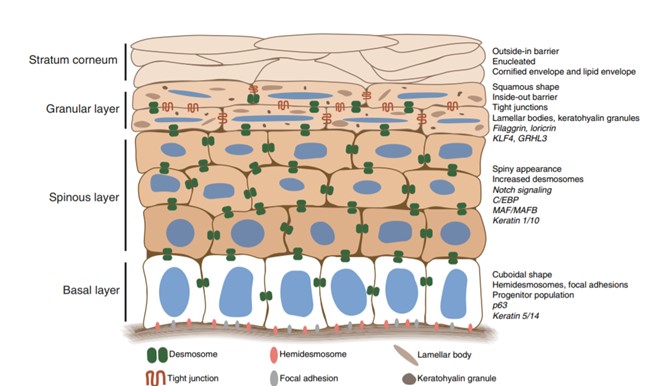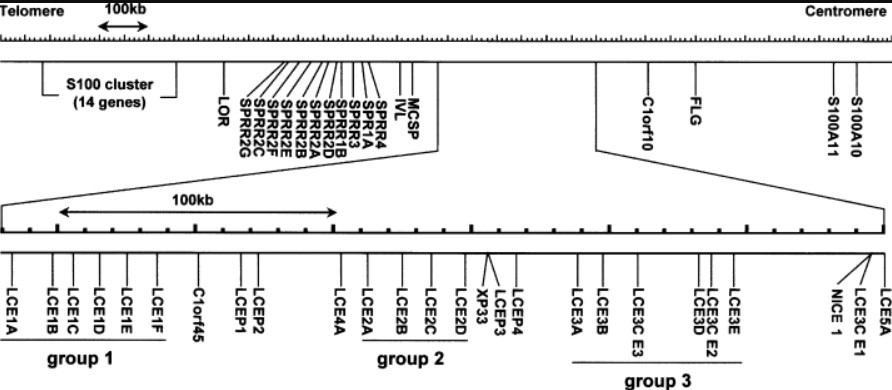LCE1a2
From Proteopedia
(Difference between revisions)
| Line 21: | Line 21: | ||
== LCE1a2 == | == LCE1a2 == | ||
| - | In this research specifically, LCE1a2 (found in mice) was looked into to try and create a structural model of it as well as produce a background. Although the specific function of the stratum-corneum proteins that this gene codes for | + | In this research specifically, LCE1a2 (found in mice) was looked into to try and create a structural model of it as well as produce a background. Although the specific function of the stratum-corneum proteins that this gene codes for were not determined, the information needed for potential sequencing and future studies were found. The general biological process of this protein is keratinization which was to be expected and further research confirmed it to be a signaling protein for the epidermis. Upon further research, the structure of the gene was able to be estimated with 98 percent confidence with respect to the homology of the sequence to the structure formed utilizing Phyr2 programming. To achieve these results the DNA sequence of the LCE1a2 cluster was located via the UniProt page [https://www.uniprot.org/uniprot/Q5TA81]. Once the sequence was found a blast was conducted in order to identify the different proteins that the gene codes for. The protein labeled Late cornified envelope 1A2 Mus musculus (late_cornified_envelope_1A2_[Mus_musculus]) was chosen as it was of the same species and location of the intended search, it was also the highest match probability made by the system. Other proteins produced were late_cornified_envelope_protein_1C-like_[Onychomys_torridus], small_proline_rich-like_2,_partial_[Mus_musculus], small_proline_rich-like_3,_partial_[Mus_musculus], and late_cornified_envelope_1A1_[Mus_musculus]. The reason for the prevalence of small protein rich proteins is due to the reason stated prior which is the fact that LCE’s and SPPRs are located right next to each other with the genome. As a result, their makeup will more than likely be very similar; due to the high predictive aspects involved with LCE’s currently, it is no surprise that SPRRs showed up in the protein list as potential matches for the proteins that LCE gene 1a2 codes for. With all of that aside once the protein of intent was identified which was late_cornified_envelope_1A2_[Mus_musculus] it was run and analyzed. Results indicated can be found here [https://docs.google.com/document/d/1obxMGO855EPB0O10tO7ktd5_wShOpKsf/edit?usp=sharing&ouid=112847009806879010488&rtpof=true&sd=true]. In addition to the protein, a look into the gene itself was done. The DNA sequence of the LCE1a2 gene was obtained and input into an in-silico Gibson assembly cloning method with Laser Gene. Results indicate that the gene has high complexity naturally making the sequencing process slightly more complex as well. The site used to determine complexity can be found here[https://www.idtdna.com/pages]: after getting to the site and creating an account be sure to click products and services then click costume DNA. This will allow you to view all of the information need to sequence your subject. |
Although the direct capabilities of the proteins coded for via the LCE clusters are still not known, the information provided above gives not only background of the topic of LCE’s but also provides a look into the structure and properties of a protein from LCE1a2 cluster. In addition to the characteristics of a protein found within the gene cluster, the steps used to find and analyze the protein was given. Alongside the protein, a clonal sequence was produced to provide additional sequence characteristics such as melting point and complexity. Those results can be found here [https://docs.google.com/document/d/1ksBWboifsRKvl51sPhwnniiDPmeDZDxTF9RiGZhm24c/edit?usp=sharing]. | Although the direct capabilities of the proteins coded for via the LCE clusters are still not known, the information provided above gives not only background of the topic of LCE’s but also provides a look into the structure and properties of a protein from LCE1a2 cluster. In addition to the characteristics of a protein found within the gene cluster, the steps used to find and analyze the protein was given. Alongside the protein, a clonal sequence was produced to provide additional sequence characteristics such as melting point and complexity. Those results can be found here [https://docs.google.com/document/d/1ksBWboifsRKvl51sPhwnniiDPmeDZDxTF9RiGZhm24c/edit?usp=sharing]. | ||
Revision as of 16:24, 28 April 2022
Structure
| |||||||||||
References
- ↑ Hanson, R. M., Prilusky, J., Renjian, Z., Nakane, T. and Sussman, J. L. (2013), JSmol and the Next-Generation Web-Based Representation of 3D Molecular Structure as Applied to Proteopedia. Isr. J. Chem., 53:207-216. doi:http://dx.doi.org/10.1002/ijch.201300024
- ↑ Herraez A. Biomolecules in the computer: Jmol to the rescue. Biochem Mol Biol Educ. 2006 Jul;34(4):255-61. doi: 10.1002/bmb.2006.494034042644. PMID:21638687 doi:10.1002/bmb.2006.494034042644
- ↑ Jackson B, Tilli CM, Hardman MJ, Avilion AA, MacLeod MC, Ashcroft GS, Byrne C. Late cornified envelope family in differentiating epithelia--response to calcium and ultraviolet irradiation. J Invest Dermatol. 2005 May;124(5):1062-70. PMID:15854049 doi:http://dx.doi.org/JID23699
- ↑ Niehues H, Tsoi LC, van der Krieken DA, Jansen PAM, Oortveld MAW, Rodijk-Olthuis D, van Vlijmen IMJJ, Hendriks WJAJ, Helder RW, Bouwstra JA, van den Bogaard EH, Stuart PE, Nair RP, Elder JT, Zeeuwen PLJM, Schalkwijk J. Psoriasis-Associated Late Cornified Envelope (LCE) Proteins Have Antibacterial Activity. J Invest Dermatol. 2017 Nov;137(11):2380-2388. doi: 10.1016/j.jid.2017.06.003., Epub 2017 Jun 17. PMID:28634035 doi:http://dx.doi.org/10.1016/j.jid.2017.06.003
- ↑ Lehrer RI, Barton A, Daher KA, Harwig SS, Ganz T, Selsted ME. Interaction of human defensins with Escherichia coli. Mechanism of bactericidal activity. J Clin Invest. 1989 Aug;84(2):553-61. doi: 10.1172/JCI114198. PMID:2668334 doi:http://dx.doi.org/10.1172/JCI114198
- ↑ Henry J, Toulza E, Hsu CY, Pellerin L, Balica S, Mazereeuw-Hautier J, Paul C, Serre G, Jonca N, Simon M. Update on the epidermal differentiation complex. Front Biosci (Landmark Ed). 2012 Jan 1;17(4):1517-32. doi: 10.2741/4001. PMID:22201818 doi:http://dx.doi.org/10.2741/4001
- ↑ Jackson B, Tilli CM, Hardman MJ, Avilion AA, MacLeod MC, Ashcroft GS, Byrne C. Late cornified envelope family in differentiating epithelia--response to calcium and ultraviolet irradiation. J Invest Dermatol. 2005 May;124(5):1062-70. PMID:15854049 doi:http://dx.doi.org/JID23699


